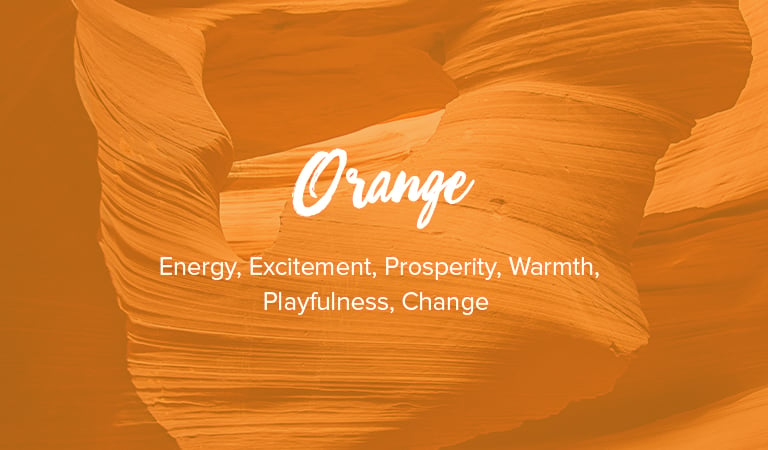
Orange is the colour between yellow and red on the spectrum of visible light. Human eyes perceive orange when observing light with a dominant wavelength between roughly 585 and 620 nanometres.

In painting and traditional colour theory, it is a secondary colour of pigments, created by mixing yellow and red. It is named after the fruit of the same name.

The first recorded use of orange as a colour name in English was in 1502, in a description of clothing purchased for Margaret Tudor. Other sources cite the first recorded use as 1512, in a will now filed with the Public Record Office. The place-name "Orange" has a separate etymology and is not related to that of the color.

The orange colour of carrots, pumpkins, sweet potatoes, oranges, and many other fruits and vegetables comes from carotenes, a type of photosynthetic pigment. These pigments convert the light energy that the plants absorb from the sun into chemical energy for the plants' growth.

In Europe and America, surveys show that orange is the colour most associated with amusement, the unconventional, extroverts, warmth, fire, energy, activity, danger, taste and aroma.

In Asia it is an important symbolic colour of Buddhism and Hinduism. In English, the colour orange is named after the appearance of the ripe orange fruit.

The word comes from the Old French orange, from the old term for the fruit, pomme d'orange. The French word, in turn, comes from the Italian arancia, based on Arabic nāranj, derived from the Sanskrit nāraṅga (नारङ्ग).

In ancient Egypt, artists used an orange mineral pigment called realgar for tomb paintings, as well as other uses. It was also used later by Medieval artists for the colouring of manuscripts. Pigments were also made in ancient times from a mineral known as orpiment.

It is found in volcanic fumaroles, low-temperature hydrothermal veins, and hot springs and is formed both by sublimation and as a byproduct of the decay of another arsenic mineral, realgar. Orpiment takes its name from the Latin auripigmentum (aurum, "gold" + pigmentum, "pigment") because of its deep-yellow color.
In Confucianism, the religion and philosophy of ancient China, orange was the colour of transformation. In China and India, the colour took its name not from the orange fruit, but from saffron, the finest and most expensive dye in Asia.

According to Confucianism, existence was governed by the interaction of the male active principle, the yang, and the female passive principle, the yin. Yellow was the colour of perfection and nobility; red was the colour of happiness and power.
Yellow and red were compared to light and fire, spirituality and sensuality, seemingly opposite but really complementary. Out of the interaction between the two came orange, the colour of transformation.

In Buddhism orange (or more precisely saffron) was the colour of illumination, the highest state of perfection. The robe and its colour is a sign of renunciation of the outside world and commitment to the order.

The candidate monk, with her master, first appears before the monks of the monastery in her own clothes, with her new robe under her arm. and asks to enter the order.

She then takes his vows, puts on the robes, and with her begging bowl, goes out to the world. Thereafter, she spends her mornings begging and her afternoons in contemplation and study, either in a forest, garden, or in the monastery.
Metacognition is "cognition about cognition", "thinking about thinking", "knowing about knowing", becoming "aware of one's awareness" and higher-order thinking skills. The term comes from the root word meta, meaning "beyond", or "on top of".

Metacognition can take many forms; it includes knowledge about when and how to use particular strategies for learning or problem-solving. There are generally two components of metacognition: (1) knowledge about cognition and (2) regulation of cognition.
Writings on metacognition date back at least as far as two works by the Greek philosopher Aristotle (384–322 BC): On the Soul and the Parva Naturalia.
Andreas Demetriou's theory (one of the neo-Piagetian theories of cognitive development) used the term hypercognition to refer to self-monitoring, self-representation, and self-regulation processes, which are regarded as integral components of the human mind.

Moreover, with his colleagues, he showed that these processes participate in general intelligence, together with processing efficiency and reasoning, which have traditionally been considered to compose fluid intelligence.

Metacognition also involves thinking about one's own thinking process such as study skills, memory capabilities, and the ability to monitor learning. Metacognitive knowledge is about one's own cognitive processes and the understanding of how to regulate those processes to maximize learning.

Metacognition refers to a level of thinking that involves active control over the process of thinking that is used in learning situations. Planning the way to approach a learning task, monitoring comprehension, and evaluating the progress towards the completion of a task: these are skills that are metacognitive in their nature.

Similarly, maintaining motivation to see a task to completion is also a metacognitive skill. The ability to become aware of distracting stimuli – both internal and external – and sustain effort over time also involves metacognitive or executive functions. The theory that metacognition has a critical role to play in successful learning means it is important that it be demonstrated by both students and teachers.

Individuals with a high level of metacognitive knowledge and skill identify blocks to learning as early as possible and change "tools" or strategies to ensure goal attainment.
The fundamental cause of the trouble is that in the modern world the stupid are cocksure while the intelligent are full of doubt.

Metacognologists are aware of their own strengths and weaknesses, the nature of the task at hand, and available "tools" or skills. A broader repertoire of "tools" also assists in goal attainment. When "tools" are general, generic, and context independent, they are more likely to be useful in different types of learning situations.

Another distinction in metacognition is executive management and strategic knowledge. Executive management processes involve planning, monitoring, evaluating and revising one's own thinking processes and products.

Strategic knowledge involves knowing what (factual or declarative knowledge), knowing when and why (conditional or contextual knowledge) and knowing how (procedural or methodological knowledge). Both executive management and strategic knowledge metacognition are needed to self-regulate one's own thinking and learning.
Metacognitive characteristics of attitudes may be key to understanding how attitudes change. Research shows that the frequency of positive or negative thoughts is the biggest factor in attitude change.
When people view lifestyle changes as coming from themselves, the effects are more powerful than if the changes were coming from a friend or family member. These thoughts can be re-framed in a way that emphasizes personal importance, such as "I want to stop smoking because it is important to me" rather than "quitting smoking is important to my family".
People have secondary cognitions about the appropriateness, justifiably, and social judgability of their own stereotypical beliefs. People know that it is typically unacceptable to make stereotypical judgments and make conscious efforts not to do so. Subtle social cues can influence these conscious efforts.

For example, when given a false sense of confidence about their ability to judge others, people will return to relying on social stereotypes.
Metacognologists believe that the ability to consciously think about thinking is unique to sapient species and indeed is one of the definitions of sapience or wisdom.

There is evidence that rhesus monkeys, apes, and dolphins can make accurate judgments about the strengths of their memories of fact and monitor their own uncertainty, while attempts to demonstrate metacognition in birds have been inconclusive.

Metacognitive-like processes are especially ubiquitous when it comes to the discussion of self-regulated learning. Being engaged in metacognition is a salient feature of good self-regulated learners. The activities of strategy selection and application include those concerned with an ongoing attempt to plan, check, monitor, select, revise, evaluate, etc.

Metacognition is 'stable' in that learners' initial decisions derive from the pertinent facts about their cognition through years of learning experience. Simultaneously, it is also 'situated' in the sense that it depends on learners' familiarity with the task, motivation, emotion, and so forth.

Individuals need to regulate their thoughts about the strategy they are using and adjust it based on the situation to which the strategy is being applied. At a professional level, this has led to emphasis on the development of reflective practice, particularly in the education and health-care professions.

"Metastrategic knowledge" (MSK) is a sub-component of metacognition that is defined as general knowledge about higher order thinking strategies. MSK had been defined as "general knowledge about the cognitive procedures that are being manipulated".

The knowledge involved in MSK consists of "making generalizations and drawing rules regarding a thinking strategy" and of "naming" the thinking strategy.

Higher-order thinking, known as higher order thinking skills (HOTS), is a concept of education reform based on learning taxonomies (such as Bloom's taxonomy).

The idea is that some types of learning require more cognitive processing than others, but also have more generalized benefits.

In Bloom's taxonomy, for example, skills involving analysis, evaluation and synthesis (creation of new knowledge) are thought to be of a higher order than the learning of facts and concepts which requires different learning and teaching methods.

Higher-order thinking involves the learning of complex judgmental skills such as critical thinking and problem solving. Higher-order thinking is more difficult to learn or teach but also more valuable because such skills are more likely to be usable in novel situations (i.e., situations other than those in which the skill was learned).

In the original version of the taxonomy, the cognitive domain is broken into the following six levels of objectives. Remember, Understand, Apply, Analyze, Evaluate, Create (rather than Synthesize).
Knowledge involves recognizing or remembering facts, terms, basic concepts, or answers without necessarily understanding what they mean. Its characteristics may include:
- Knowledge of specifics—terminology, specific facts
- Knowledge of ways and means of dealing with specifics—conventions, trends and sequences, classifications and categories, criteria, methodology
- Knowledge of the universals and abstractions in a field—principles and generalizations, theories and structures

Comprehension involves demonstrating an understanding of facts and ideas by organizing, comparing, translating, interpreting, giving descriptions, and stating the main ideas.

Application involves using acquired knowledge—solving problems in new situations by applying acquired knowledge, facts, techniques and rules. Learners should be able to use prior knowledge to solve problems, identify connections and relationships and how they apply in new situations.
Analysis involves examining and breaking information into component parts, determining how the parts relate to one another, identifying motives or causes, making inferences, and finding evidence to support generalizations. Its characteristics include:
- Analysis of elements
- Analysis of relationships
- Analysis of organization

Synthesis involves building a structure or pattern from diverse elements; it also refers to the act of putting parts together to form a whole. Its characteristics include:
- Production of a unique communication
- Production of a plan, or proposed set of operations
- Derivation of a set of abstract relations

Evaluation involves presenting and defending opinions by making judgments about information, the validity of ideas, or quality of work based on a set of criteria. Its characteristics include:
- Judgments in terms of internal evidence
- Judgments in terms of external criteria

Skills in the affective domain describe the way people react emotionally and their ability to feel other living things' pain or joy. Affective objectives typically target the awareness and growth in attitudes, emotion, and feelings.
Receiving
The lowest level; the student passively pays attention. Without this level, no learning can occur. Receiving is about the student's memory and recognition as well.

Responding
The student actively participates in the learning process, not only attends to a stimulus; the student also reacts in some way.

Valuing
The student attaches a value to an object, phenomenon, or piece of information. The student associates a value or some values to the knowledge they acquired.

Organizing
The student can put together different values, information, and ideas, and can accommodate them within his/her own schema; the student is comparing, relating and elaborating on what has been learned.

Characterizing
The student at this level tries to build abstract knowledge.

Skills in the psychomotor domain describe the ability to physically manipulate a tool or instrument like a hand or a hammer. Psychomotor objectives usually focus on change and/or development in behavior and/or skills.
Perception
The ability to use sensory cues to guide motor activity: This ranges from sensory stimulation, through cue selection, to translation.

Set
Readiness to act: It includes mental, physical, and emotional sets. These three sets are dispositions that predetermine a person's response to different situations (sometimes called mindsets). This subdivision of psychomotor is closely related with the "responding to phenomena" subdivision of the affective domain.

Guided response
The early stages of learning a complex skill that includes imitation and trial and error: Adequacy of performance is achieved by practicing.

Mechanism
The intermediate stage in learning a complex skill: Learned responses have become habitual and the movements can be performed with some confidence and proficiency.
Complex Overt Response
The skillful performance of motor acts that involve complex movement patterns: Proficiency is indicated by a quick, accurate, and highly coordinated performance, requiring a minimum of energy.

Adaptation
Skills are well developed and the individual can modify movement patterns to fit special requirements.

Origination
Creating new movement patterns to fit a particular situation or specific problem: Learning outcomes emphasize creativity based upon highly developed skills.

Some consider the three lowest levels as hierarchically ordered, but the three higher levels as parallel. Others say that it is sometimes better to move to Application before introducing concepts, the idea is to create a learning environment where the real world context comes first and the theory second to promote the student's grasp of the phenomenon, concept or event.

The distinction between the categories can be seen as artificial since any given cognitive task may entail a number of processes. It could even be argued that any attempt to nicely categorize cognitive processes into clean, cut-and-dried classifications undermines the holistic, highly connective and interrelated nature of cognition.
The ability to interface with and create media would draw upon skills from both higher order thinking skills including analysis, evaluation, and creation and lower order thinking skills which are remembering, comprehending, and application.

Wisdom, sapience, or sagacity is the ability to think and act using knowledge, experience, understanding, common sense and insight.

Wisdom is associated with attributes such as unbiased judgment, compassion, experiential self-knowledge, self-transcendence and non-attachment

I am wiser than this man; for neither of us really knows anything fine and good, but this man thinks he knows something when he does not, whereas I, as I do not know anything, do not think I do either.

Thus it became popularly immortalized in the phrase "I know that I know nothing" that it is wise to recognize one's own ignorance and to value epistemic humility.













No comments:
Post a Comment